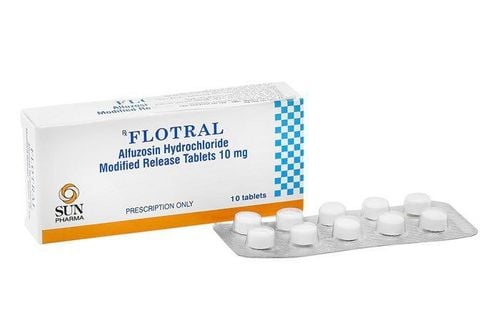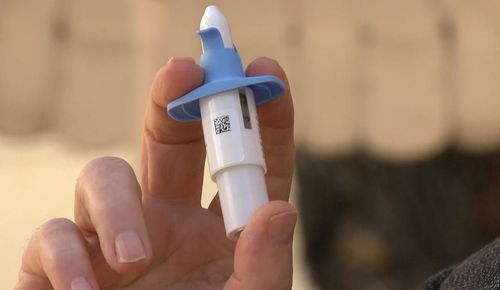This is an automatically translated article.
Utralene drug with active ingredient sertraline is commonly used in the treatment of depression. This product includes 2 strengths, utralene 50mg and drug utralene 100mg. So how should patients use Utralene and what should be noted during treatment?
1. What is Utralene?
Utralene medicine has the main active ingredient is Sertraline. The drug is prepared in the form of film-coated tablets, including 2 concentrations, Utralene 100mg and Utralene 50mg. The mechanism of action of the active ingredient sertraline in Utralene is to inhibit serotonin reuptake in nerve fibers of the central nervous system. Some in vitro animal studies have also suggested that sertraline selectively inhibits serotonin reuptake and has only a very weak effect on other chemical mediators (such as norepinephrine and dopamine).
In vitro studies have also shown that sertraline has no appreciable affinity for adrenergic, cholinergic, GABA, dopaminergic, histaminergic, serotonergic or benzodiazepine receptors. Therefore, utralene does not provide anticholinergic, sedative and cardiovascular effects like other psychotropic drugs.
2. Indications of the drug Utralene
Utralene is indicated for use in the treatment of the following diseases:
Depression; Phobias Disorder Cases of fear, fear, panic attacks, panic attacks with or without claustrophobia. The patient's characteristic is a state of sudden panic, anxiety about the condition and complications of a particular disease or changes in attitude and behavior related to the disease.

Thuốc Utralene 50mg được sử dụng trong điều trị bệnh trầm cảm
3. Instructions for use and dosage of Utralene
3.1. How to use the drug Utralene 100mg and Utralene 50mg Utralene film coated tablets are used orally, once a day only in the morning or evening. When using Utralene, it should be taken with a sufficient amount of water and can be taken with or without food.
3.2. Dosage of Utralene Adult:
The usual dose is 50mg sertraline/day, if necessary it can be increased to 100mg/day; The maximum dose of Utralene is 200mg/day; When the dose must be increased, it should be increased in increments of 50 mg for at least 1 week; For cases where Utralene needs to be used for a long time, the doctor should consider appointing the lowest dose sufficient to bring about effective treatment. Children and adolescents: Utralene film-coated tablets are not recommended for use in children and people under 18 years of age.
Elderly: The half-life of Utralene may be prolonged in this group of subjects, so it is necessary to reduce the dose appropriately when using it.
Patients with liver failure: Care should be taken when using Utralene. Although it is recommended that patients with liver failure do not need to adjust the dose of Utralene, it is best to reduce the dose or extend the time between doses. In cases of severe liver failure, Utralene should not be used because there are no valid clinical data.
Patients with renal failure: No dose adjustment of Utralene is required in this subject, but they need to be closely monitored, especially during long-term treatment.
3.3. Time to use the drug Utralene Utralene drug starts to bring about antidepressant effects in about 7 days, but the maximum effect is usually reached within 2-4 weeks of taking the drug.
The duration of treatment with Utralene depends on the nature and severity of the mental disorder. After the symptoms have subsided, the patient must continue to take medication to control the disease for at least 6 months.
Note that patients should avoid stopping Utralene too suddenly. When discontinuation of therapy is indicated, the dose should be reduced gradually over a period of 1-2 weeks to limit the risk of a discontinuation reaction. In the event that an intolerable condition occurs after a dose reduction or discontinuation of Utralene, the patient may have to resume the previous dose. Your doctor will then instruct you to continue on a slower dose reduction regimen before stopping completely.
3.4. Symptoms of an overdose of Utralene may include drowsiness, gastrointestinal disturbances (such as nausea or vomiting), tachycardia, tremors, anxiety, dizziness, and lightheadedness. or even coma (coma is very rare). The current literature shows that sertraline is highly safe even in overdose, even in some cases, a single dose of sertraline up to 13.5g has been taken. The dangers of Utralene poisoning mostly occur when used concurrently with other drugs and/or alcohol and require aggressive treatment.
To date there is no specific antidote for sertraline. Therefore, supportive measures for Utralene overdose are mainly such as ensuring adequate oxygen supply, using activated charcoal (can be combined with sorbitol or other enema when necessary) or gastric lavage (not very effective). . The use of emetics is not appropriate for this condition. Some other measures such as diuretics, hemodialysis, transfusion or exchange are unlikely to be effective for drugs with a large volume of distribution such as sertraline.

Người bệnh nên dùng thuốc Utralene 50mg đúng liều lượng chỉ định
4. Utralene side effects
When using Utralene, patients may experience undesirable effects (ADRs) according to the following levels:
4.1. Common Utralene side effects Plant nervous system disorders Side effects of Utralene drugs on the cardiovascular system: Palpitations, chest pain; Central nervous system and peripheral nervous system disorders: Utralene drug increases tone, decreases sensation; Gastrointestinal disorders: Increased appetite; Other disorders: Back pain, weakness, irritability, weight gain; Musculoskeletal system disorders: myalgia; Respiratory system disorders: Rhinitis; Tinnitus. 4.2. Uncommon side effects of the drug Utralene Nervous system disorders: flushing, increased salivation, cold and moist skin, dilated pupils; Side effects of the drug Utralene on the cardiovascular system: Hypertension, tachycardia, dizziness, orthostatic hypotension, edema around the orbits, peripheral edema, hypotension, ischemia, syncope... ; Central and peripheral nervous system disorders: convulsions, confusion, hyperactivity, dizziness, abnormal coordination, increased sensation, cramps, abnormal gait...; Skin and adnexal disorders: Pruritus, acne, urticaria, dry skin, skin rash, photosensitivity, maculopapular rash; Gastrointestinal disorders: dysphagia, belching, esophagitis, gastroenteritis; Other disorders: Fever, shivering, edema; Metabolic and nutritional disorders: frequent thirst. Side effects of the drug Utralene on the musculoskeletal system: Joint pain, dystonia, cramps, muscle weakness; Psychiatric disorders: Asthenia, forgetfulness, nightmares, teeth grinding, lethargy, unusual dreams, paranoia, hallucinations, aggression; Menstrual cycle disorder, bleeding in the genital tract, vaginal bleeding, vaginal discharge; Side effects of the drug Utralene on the respiratory system: Cough, shortness of breath, upper respiratory tract infection, bronchospasm, sinusitis; Side effects of the drug Utralene on the senses: Conjunctivitis, ear pain, eye pain; Urinary tract disorders: frequent urination, polyuria, urinary retention, nocturia, incontinence;
5. Contraindications of the drug Utralene
Utralene is contraindicated in the following cases:
People who are sensitive to sertraline; Concomitant use of Utralene with monoamine oxidase (MAO) and linezolid inhibitors; Concomitant use of Utralene with pimozide.

Người bệnh nên thận trọng khi dùng thuốc Utralene 50mg
6. Be careful when using the drug Utralene
Caution when using Utralene for children and adolescents under 18 years of age: there are behaviors related to suicide and hostile attitudes, if it is necessary to use Utralene, these patients must be carefully monitored for the risk of suicide; Caution with serotonergic syndrome when taking Utralene: Several serious life-threatening reactions have been reported in patients receiving Utralene in combination with a monoamine oxidase inhibitor (MAOI). Concomitant use of sertraline with other serotonergic agents such as tryptophan, fenfluramine and serotonin agonists is not recommended due to the risk of serious adverse reactions. Utralene can be started 14 days after stopping treatment with MAO inhibitors. Other serotonergic inhibitors include dextromethorphan, pethidine, tramadol, and selective serotonin reuptake inhibitors; Watch out for suicidal actions: Depression can increase suicidal ideation, self-harm and suicidal behavior, the risk of suicide may increase in the early stages of recovery, need to closely monitor the patient during treatment; Psychomotor disorders: The use of Utralene has been associated with the progression of psychomotor disorders, with signs of restlessness, feelings of irritability, anxiety, and anxiety. The patient must be constantly in motion. This condition usually occurs within the first few weeks of treatment and then increasing the dose of Utralene can be harmful; Withdrawal symptoms upon discontinuation of Utralene are very common, especially upon abrupt discontinuation, and depend on several factors such as dose, duration of administration, and rate of dose reduction. Manifestations may include dizziness, sensory disturbances (such as paresthesias and stinging sensations), sleep disturbances, anxiety, nausea, vomiting, tremors, sweating, headache, diarrhea, palpitations, mental instability, irritability and visual disturbances... Withdrawal from drug withdrawal is usually self-limited and resolves within 2 weeks, sometimes lasting up to 2-3 months; Enhancement of hypomania: In clinical trials, mania or hypomania was observed in approximately 0.4% of patients receiving Utralene. Therefore, special caution should be exercised in cases with a history of mania and hypomania. At the same time, the doctor needs to establish a strict monitoring regime and quickly stop the drug when the patient enters the manic phase; Schizophrenia: Psychotic symptoms may be aggravated by utralene in patients with schizophrenia; Seizure disorders: Seizures have been reported in approximately 0.08% of depressed patients treated with Utralene. However, sertraline has not been studied in patients with convulsive disorders, so utralene should be avoided for erratic seizures and only used when the seizure status is under control; Diabetes: Patients with diabetes requiring treatment with a selective serotonin reuptake inhibitor such as Utralene may cause glycemic control loss and require an adjustment in the dose of insulin or other hypoglycemic agents; Hepatic impairment: Utralene is mainly metabolized in the liver, so this drug should not be used in patients with severe liver failure; Renal: Because Utralene is mostly metabolized in the liver, only a small part is excreted by the kidneys as unchanged drug. Reliable studies have shown that patients with renal impairment do not require dose adjustment of sertraline, but caution should be exercised in its use in this population; Pregnancy: There are no comprehensive studies on the use of Utralene in pregnant women. Therefore, it should only be used when the benefits of treatment outweigh the risks to the health of the fetus; Lactation: It is not known whether sertraline is excreted in human milk and in what quantities. It is best to exercise caution when administering Utralene to a nursing woman. The important information about the drug Utralene hopes to bring you useful knowledge to make the use process more effective.
Please dial HOTLINE for more information or register for an appointment HERE. Download MyVinmec app to make appointments faster and to manage your bookings easily.













